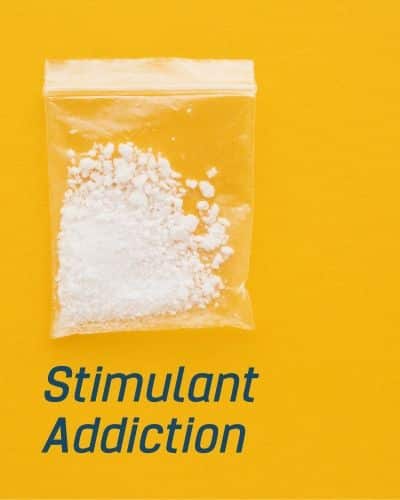Meth Addiction is a common condition that severely affects more Americans than one would think. According to the CDC, in 2018, there were 12,676 psychostimulant drug-poisoning deaths in the country. [9] In addition, The National Treatment Episode Data Set (TEDS) reports that in 2014 approximately 53 people per 100,000 were receiving care at a specialized addiction treatment facility for issues involving specifically methamphetamine. That’s only the number of people that were actually having rehabilitation treatment, not the actual number of people suffering from Meth Addiction. [1] As of 2015, around 6 percent of the American population (aged 12 and older) had tried it at least once, the National Institute on Drug Abuse (NIDA) reports. [2]
What is Methamphetamine?
According to the National Institute on Drug Abuse, methamphetamine is a powerful, highly addictive stimulant that affects the central nervous system. It was developed early in the 20th century from its parent drug, amphetamine, and was used originally in nasal decongestants and bronchial inhalers. Like amphetamine, methamphetamine causes increased activity and talkativeness, decreased appetite, and a pleasurable sense of well-being or euphoria.
However, methamphetamine differs from amphetamine in that, at comparable doses, much greater amounts of the drug get into the brain, making it a more potent stimulant. It also has longer-lasting and more harmful effects on the central nervous system. These characteristics make it a drug with a high potential for widespread misuse. [3]
On the authority of addictioncenter.com, in the piece ‘Meth Addiction And Abuse’, they state that Methamphetamine was originally prescribed as a decongestant and weight loss aid, methamphetamine was once widely and legally available in tablet and injectable forms throughout the U.S.

However, a large population abused these products for the stimulant effects, effectively prompting the FDA to restrict and regulate the drug as a schedule II controlled substance in 1970. There is currently only one prescription methamphetamine drug still on the market, Desoxyn, which is used to treat obesity and severe attention-deficient hyperactivity disorder (ADHD).
The majority of people that are addicted to methamphetamine use the drug in its illicit forms: meth and crystal meth. Meth is a crystalline powder that is most commonly white, though it can be yellow, pink, or brown. It is odorless, bitter, and can be dissolved in liquid. It’s most commonly consumed via smoking, snorting or injection. In some cases, it’s compressed into a pill and can be taken orally. Crystal meth is clear or blue and takes the shape of coarse crystals that are typically smoked.
The Current Reality of Methamphetamines
The dangers of illicit drugs don’t usually end with the effects of the substance itself. There’s always a bigger problem behind them. In the case of methamphetamine, many drug dealers will also “cut” this drug with other substances to sell less of the actual drug for the same price and fetch a greater profit margin.
In some cases, methamphetamine is cut with prescription medications, ranging from antidepressants to opioids. These additives can be extremely dangerous due to the drug interactions and increase the risk of overdose.
The vast majority of meth that is distributed today comes from illegal laboratories and imports. The product is typically cooked in “home labs” or “stovetops” in which a few people will produce small amounts of the substance.
While the structural makeup of the two variations differs, both meth and crystal meth are chemically the same thing. Street names for methamphetamine include:
- Glass
- Ice
- Crystal
- Crank
- Tweak
- Redneck cocaine
- Chalk
- No doze
- White cross
- Cotton candy
Meth is also produced in cartel “super labs” that include professional-grade equipment to produce the drug at higher quantities and quality. The key ingredient in meth is typically the stimulant ephedrine or pseudoephedrine, which is found in some common over-the-counter cough and cold medications. Meth labs are notoriously dangerous because the gas and chemicals that are released during the drug’s creation process are toxic and combustible. [4]
Why is Meth so addictive?
Meth is a stimulant drug that heightens the functions of the central nervous system, thereby increasing activity in certain areas of the brain. For example, heart rate, body temperature, respiration, and blood pressure all rise under the influence of meth.
Energy, attention, focus, pleasure, and excitement are enhanced as well, as chemical messengers in the brain, such as dopamine, are increased by the interaction of meth. Elevated levels of dopamine cause the intense “high” that is associated with meth, and the desire to recreate this feeling makes the drug extremely addictive.

According to the American Addiction Centers in the piece ‘Meth Addiction: Facts, Statistics & How Meth Changes You’, “when someone is taking meth, they are alert and energized, and can stay awake for long periods of time. When meth wears off, however, a significant “crash” generally occurs, leaving individuals feeling fatigued, lethargic, hungry, depressed, and anxious.
As a result, meth is commonly taken in a binge pattern, often called a “run,” where small amounts of meth are taken every few hours for a couple of days to prolong the high. This pattern of abuse can more quickly lead to drug dependence and addiction”. [5]
Meth Addiction’s effects on the Brain
As stated by the American Addiction Centers, “methamphetamine affects dopamine levels in the brain, causing a flood of the neurotransmitter that disrupts normal functioning. Dopamine is not only responsible for feeling pleasure, but also for motivation, movement, memory functions, learning, and reward processing. In short, meth makes a person feel good and makes them want to continue taking it to keep feeling this way”. [5]
When a person uses meth on a regular basis they will build up a tolerance to it. For this reason, people suffering from Meth Addiction will need to take higher doses of the drug in order to get the same effects as before.
It may become difficult to feel happy without meth, and withdrawal symptoms like anxiety, insomnia, fatigue, increased appetite, depression, and even psychosis can occur when it wears off. This is called drug dependence, which can form rather quickly with chronic meth abuse and even faster with binge use and escalating doses.
Once dependence forms, changes are made in how the brain functions and to its chemical makeup and circuitry. Compulsive drug-seeking behaviors and a loss of the ability to control how much and how often meth is taken can occur. This inability to control meth use coupled with the changes made in the brain are some of the primary hallmarks of addiction.
Addiction can create a myriad of social, emotional, physical, and behavioral issues. When someone suffers from addiction to meth, getting the drug, using it, and recovering from it can consume them, and other activities take a backseat.
Interpersonal relationships suffer as mood swings can be unpredictable, and the person may consistently shirk regular responsibilities and obligations.
Grades and work output drop, and unemployment, financial strain, and homelessness can be the result of Meth Addiction. Meth abuse also leads to lowered inhibitions and an increase in risk-taking and possible suicidal behaviors.
Health problems generally crop up too. The Drug Abuse Warning Network (DAWN) publishes that over 100,000 people received medical treatment in an emergency department (ED) for meth abuse in 2011. [6]
Short-term side effects of meth abuse and addiction also include the potential for a life-threatening overdose. The effects on the heart and central nervous system can overwhelm the system and lead to seizures, heart attack, stroke, dangerously high body temperature, agitation, irregular heart rate, difficulties breathing, kidney failure, coma, and even death. When meth is mixed with other drugs, the likelihood of an adverse reaction and possible overdose increases greatly.
Symptoms of Meth Addiction
Meth is one of the most dangerous and addictive drugs on the market, due to the extreme psychological and physical toll that it takes on the body and mind. This drug deeply modifies a user’s brain and body in an unhealthy way. These symptoms and warning signs are visible in a variety of ways.
According to the piece ‘Meth Symptoms And Warning Signs’, published by Addictioncenter.com, one of the first symptoms of meth abuse is a sudden loss of interest in areas of life that were once important to the person.
Hobbies, relationships, and career goals will all begin to take a back seat to getting and using meth. Initially, many people will attempt to hide their drug use, but the longer someone uses meth, the more prominent it becomes in their lives. Methamphetamine chemically alters how a user thinks and feels, which can make what was once a recreational drug activity a major life priority.
People abusing or addicted to meth will exhibit a variety of behavioral and physical symptoms. Some of the most common signs of meth use include:
- Hyperactivity
- Twitching, facial tics, jerky movements
- Paranoia
- Dilated pupils
- Noticeable and sudden weight loss
- Skin sores
- Rapid eye movement
- Agitation
- Burns, particularly on the lips or fingers
- Erratic sleeping patterns
- Rotting teeth
- Outbursts or mood swings
- Extreme weight loss
- Reduced appetite
Another telling symptom of meth use is “tweaking” – a period of anxiety and insomnia that can last for 3 to 15 days. Tweaking occurs at the end of a drug binge when a person using meth can’t achieve a rush or high any longer.
Tweaking can cause psychological side effects, such as paranoia, irritability, and confusion due to the desperation to use again. Tweaking from meth can also cause people to experience hallucinations and become prone to violent behavior.
Another sign that someone is using meth is the crash phase. During this period, the body is deprived of the dopamine that meth was previously supplying and causes extreme exhaustion. A crash can last anywhere from 1 to 3 days and is characterized by long periods of sleep, intense drug cravings, and depression. [7]
Treatment for Meth Addiction
As it was mentioned before, the longer someone takes meth, and the higher the dosage, the more severely dependent on the drug they are likely to be. A high level of dependence means that withdrawal will be difficult. Withdrawal symptoms are optimally managed through a medical detox regime like that provided in a comprehensive treatment program.
There are no specific medications designed to treat Meth Addiction; however, some medications can be helpful in managing specific symptoms of withdrawal like those that address depression, anxiety, and tremors.
The National Library of Medicine (NLM) reports that the sooner someone receives help for meth abuse, the better the long-term prognosis is. Meth is highly addictive, and the emotional lows and severe drug cravings associated with its use can make relapse highly likely. [8]
It is important to stay vigilant and for an individual to remain in an addiction treatment program for long enough to form healthy habits, to allow new brain connections to form, and to learn relapse prevention techniques to control cravings.
Behavioral therapies are usually considered the ideal form of treatment for Meth Addiction, according to the National Institute on Drug Abuse. [2] Cognitive Behavioral Therapy (CBT) uses both individual and group sessions to teach stress management, coping tools, communication, and other life skills to maintain abstinence and improve thinking and behavior patterns overall.

Another form of behavioral therapy used for meth and stimulant addiction is one that uses motivational incentives, or contingency management, as a method to maintain sobriety. With this program, individuals are rewarded for clean drug tests, and this can help to boost treatment compliance and the motivation to continue to remain drug-free.
Support groups, such as the 12-Step-based program Crystal Meth Anonymous (CMA), can connect individuals with peers who can relate to what they are going through and offer hope, encouragement, and tips on remaining abstinent. Family therapy, counseling, and educational programs can all help to promote a lasting recovery as well.
Methamphetamine can cause long-term damage to the brain, which can require specialized treatment and continuous care over a sustained period of time to promote abstinence. With proper treatment, individuals can learn to manage the possible side effects of repeated abuse and disruption to the brain, and minimize instances of relapse for a healthy recovery. [5]
Reclaim your life from Meth Addiction
Meth Addiction is a serious condition that should not be taken lightly. We Level Up Treatment Center can provide you, or someone you love, the tools to recover from Meth Addiction with professional and safe treatment. Feel free to call us to speak with one of our counselors. We can inform you about this condition by giving you relevant information. Our specialists know what you are going through. Please know that each call is private and confidential.
Sources:
[1] National Treatment Episode Data Set (Samhsa.gov)
[2] National Institute on Drug Abuse (Drugabuse.gov/)
[3] ‘Methamphetamine Research Report. What is methamphetamine?’ – National Institute on Drug Abuse (www.drugabuse.gov)
[4] ‘Meth Addiction And Abuse’ – Addictioncenter.com
[5] ‘Meth Addiction: Facts, Statistics & How Meth Changes You’ – Americanaddictioncenters.org
[6] The Drug Abuse Warning Network (www.samhsa.gov)
[7] ‘Meth Symptoms And Warning Signs’ – Addictioncenter.com
[8] The National Library of Medicine (https://www.nlm.nih.gov/)
[9] Centers for Disease Control and Prevention (cdc.gov)